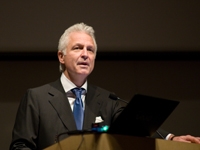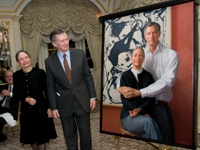The brightest minds in neurological surgery in New York and beyond gathered at the Rockefeller Auditorium on Friday, Dec. 5, for a special program highlighting the rich history of the field, and the groundbreaking contributions of one particular neurosurgeon.
"New Frontiers in Neurological Surgery," organized by the Department of Neurological Surgery at Weill Cornell Medical College and hosted by Professor and Chairman Dr. Philip E. Stieg, gathered together more than a dozen physicians from Weill Cornell, Memorial Sloan-Kettering Cancer Center, Rockefeller University and the University of Southern California.

Dr. Philip Stieg discussing the history of neurological surgery at NewYork-Presbyterian/Weill Cornell during the "New Frontiers in Neurological Surgery" symposium, Dec. 5.
The physicians delivered brief talks on the current state of neurological surgery and the new technologies that will yield advanced treatment and diagnostic methods.
A reception and dinner at the St. Regis Hotel followed the program.
While the hopes of tomorrow were broadly discussed, Dr. Stieg took an opportunity to look back at the genesis of neurological surgery at NewYork-Presbyterian Hospital/Weill Cornell Medical Center, specifically the significant contributions of Dr. Russel Hugo Patterson.
"He is a translational researcher in the truest, most hands-on sense of the word," Dr. Stieg said of Dr. Patterson, who attended the program with his wife, Juliet Boyd Patterson. "He saw the translational train coming. So he laid the tracks we are running on today. He also built the train and kept it running on time."
A 1952 graduate of what was then the Cornell University Medical College, Dr. Patterson went on to serve as the attending-surgeon-in-charge of neurosurgery at the New York Hospital, and president of an array of professional organizations, including the American Association of Neurological Surgeons, the American Academy of Neurological Surgery, the Society of Neurological Surgeons, the New York State Neurological Surgical Society and the New York Society of Neurosurgery. In 2000, Dr. Patterson received the Cushing Medal, the highest honor granted by the American Association of Neurological Surgeons.

Dr. Russel Patterson and his wife, Juliet, unveil their portrait at the dinner reception following the symposium.
In 1971, when Dr. Patterson was named neurosurgeon-in-charge at New York Hospital, he also published a paper in the Journal of the American Medical Association on his invention of a filter that removed 99 percent of microemboli (small blood clots) from the bloodstream.
Dr. Patterson also helped pioneer the use of deep hypothermia in surgery. In one instance, in 1966, Dr. Patterson removed two aneurysms from a patient using the technique.
"When the body temperature [of the patient] was 5 degrees Celsius and the brain temperature was about 12 to 15 degrees, all the blood was drained from the body," Dr. Stieg explained. "Surgery began and repair of the aneurysm took 29 minutes. This was one of 30 such operations done at the New York Hospital at the time, using the hypothermia technique."
Dr. Patterson's legacy extends far beyond surgical innovation. His true mark might best be measured in the residents he trained and the careers he has helped guide.
"Where would we be today, as neurosurgeons and translational researchers, if Dr. Patterson had not helped build the tracks that take us on our journey?" Dr. Stieg said.
Photography by Amelia Panico.

